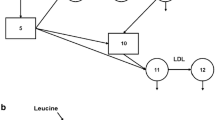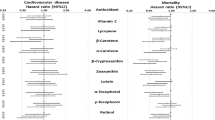Abstract
Serum ubiquinone levels were studied during long- and short-term treatment with 3-hydroxy-3-methylglutaryl-coenzyme A reductase inhibitors in 17 men with primary non-familial hypercholesterolaemia. The serum ubiquinone levels were determined after the patients had received simvastatin (20–40 mg per day) for 4.7 years, after a 4 week treatment pause and again after they had resumed treatment with lovastatin (20–40 mg per day) for 12 weeks.
During the treatment pause the average serum ubiquinone levels increased by 32%; resumption of treatment caused a reduction of 25%. The changes in the levels of ubiquinone and serum total cholesterol as well as those of ubiquinone and low-density lipoprotein cholesterol were closely parallel.
This suggested that changes in serum ubiquinone reflected changes in cholesterol-containing serum lipoproteins which could serve as carrier vehicles for ubiquinone. After long-term simvastain treatment and after short-term lovastatin treatment, average serum ubiquinone levels (1.16 and 1.22 mg·l-1, respectively) were similar to that observed in a group of apparently healthy middle-aged men (1.16 mg·l-1).
Similar content being viewed by others
References
Grundy SM (1988) HMG-CoA reductase inhibitors for treatment of hypercholesterolemia. N Engl J Med 319: 24–33
Bilheimer DW, Grundy SM, Brown MS, Goldstein JL (1983) Mevinolin and colestipol stimulate receptor-mediated clearance of low density lipoprotein from plasma in familial hypercholesterolemia heterozygotes. Proc Natl Acad Sci USA 80: 4124–4128
Tikkanen MJ, Bocanegra TS, Walker JF, Cook T (1989) Comparison of low-dose simvastatin and gemfibrozil in the treatment of elevated plasma cholesterol. Am J Med 87 [Suppl 4A]: 47S-53S
Tikkanen MJ, Helve E, Jäättelä A, Kaarsalo E, Lehtonen A, Malbecq W, Oksa H, Pääkkönen P, Salmi J, Veharanta T, Viikari J, Äärynen M and the Finnish Lovastatin Study Group (1988) Comparison between lovastatin and gemfibrozil in the treatment of primary hypercholesterolemia: the Finnish multicenter study. Am J Cardiol 62: 35J-43J
Hunninghake DB (1992) HMG CoA reductase inhibitors. Curr Opin Lipidol 3: 22–28
Tobert JA, Shear CL, Chremos AN, Mantell GE (1990) Clinical experience with lovastatin. Am J Cardiol 65: 23F-26F
Ojala J-P, Helve E, Karjalainen K, Tarkkanen A, Tikkanen MJ (1990) Long-term maintenance of therapeutic response to lovastatin in patients with familial and non-familial hypercholesterolemia: a 3-year follow-up. Atherosclerosis 82: 85–95
Goldstein JL, Brown MS (1990) Regulation of the mevalonate pathway. Nature 343: 425–430
Olson RE, Rudney H (1983) Biosynthesis of ubiquinone. Vitam Horm 40: 1–43
Greenberg S, Frishman WH (1990) Co-enzyme Q10: a new drug for cardiovascular disease. J Clin Pharmacol 30: 596–608
Mohr D, Bowry VW, Stocker R (1992) Dietary supplementation with coenzyme Q10 results in increased levels of ubiquinol-10 within circulating lipoproteins and increased resistance of human low-density lipoprotein to the initiation of lipid peroxidation. Biochim Biophys Acta 1126: 247–254
Steinberg D, Parthasarathy S, Carew TE, Khoo JC, Witztum JL (1989) Beyond cholesterol. Modifications of low-density lipoprotein that increase its atherogenicity. N Engl J Med 320: 915–924
Helve E, Ojala J-P, Tikkanen MJ (1988) Simvastatin and gemfibrozil in the treatment of primary hypercholesterolemia. J Appl Cardiol 3: 381–388
Gotto AM, Bierman EL, Connor WE, Ford CH, Frantz ID, Glueck CJ, Grundy SM, Little JA (1984) Recommendations for treatment of hyperlipidemia in adults. A joint statement of the nutrition committee and the council on arteriosclerosis. Circulation 69: 1067A-1090A
Finley PR, Schifman RB, Williams RJ, Lichti DA (1978) Cholesterol in high density lipoprotein: use of Mg2+/dextran sulfate in its enzymic measurement. Clin Chem 24: 931–933
Friedewald WT, Levy RI, Fredrickson DS (1972) Estimation of the concentration of low-density lipoprotein cholesterol in plasma, without use of the preparative ultracentrifuge. Clin Chem 18: 499–502
Okamoto T, Fukui M, Nakamoto M, Kishi T (1985) High-performance liquid chromatography of coenzyme Q-related compounds and its application to biological materials. J Chromatogr 342: 35–46
Littarru GP, Ghirlanda G, Lippa S (1989) Effect of simvastatin on plasma CoQ10 level. Tenth International Symposium on Drugs Affecting Lipid Metabolism (abstract 524), 8–11 November, Houston, Texas
Kaplan LA, Fearn JA, Laskarzewski PM, Stein EA (1990) Serum ubiquinone Q10 levels: effect of cholesterol-lowering drugs (abstract). Clin Chem 36: 963
Elmberger PG, Kalen A, Lund E, Reihner E, Eriksson M, Berglund L, Angelin B, Dallner G (1991) Effects of pravastatin and cholestyramine on products of the mevalonate pathway in familial hypercholesterolemia. J Lipid Res 32: 935–940
Folkers K, Langsjoen P, Willis R, Richardson P, Xia L-J, Ye C-Q, Tamagawa H (1990) Lovastatin decreases coenzyme Q levels in humans. Proc Natl Acad Sci USA 87: 8931–8934
Mabuchi H, Haba T, Tatami R, Miyamoto S, Sakai Y, Wagasugi T, Watanabe A, Koizumi J, Takeda R (1981) Effects of an inhibitor of 3-hydroxy-3-methylglutaryl coenzyme A reductase on serum lipoproteins and ubiquinone-10 levels in patients with familial hypercholesterolemia. N Engl J Med 305: 478–482
Elmberger PG, Kalen A, Brunk U, Dallner G (1989) Discharge of newly synthesized dolichol and ubiquinone with lipoproteins to rat liver perfusate and to the bile. Lipids 24: 919–930
Brown MS, Goldstein JL (1980) Multivalent feedback regulation of HMG-CoA reductase, a control mechanism coordinating isoprenoid synthesis and cell growth. J Lipid Res 21: 505–517
Frei B, Kim MC, Ames BN (1990) Ubiquinol-10 is an effective lipid-soluble antioxidant at physiological concentrations. Proc Natl Acad Sci USA 87: 4879–4883
Stocker R, Bowry V, Frei B (1991) Ubiquinol-10 protects human low density lipoprotein more efficiently against lipid peroxidation than does α-tocopherol. Proc Natl Acad Sci USA 88: 1646–1650
Author information
Authors and Affiliations
Rights and permissions
About this article
Cite this article
Laaksonen, R., Ojala, J.P., Tikkanen, M.J. et al. Serum ubiquinone concentrations after short- and long-term treatment with HMG-CoA reductase inhibitors. Eur J Clin Pharmacol 46, 313–317 (1994). https://doi.org/10.1007/BF00194398
Received:
Accepted:
Issue Date:
DOI: https://doi.org/10.1007/BF00194398




